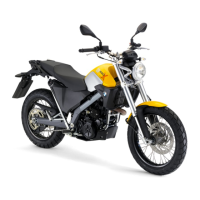Brake system with
BMW Motorrad ABS
OE
How does ABS work?
The maximum braking force that
can be transferred to the road
surface is partially dependent on
the friction coefficient of the road
surface. Gravel, ice, snow and
wet roads offer a considerably
poorer friction coefficient than a
dry, clean asphalt surface. The
poorer the friction coefficient of
the road surface is, the longer
the braking distance will be.
If the maximum transferrable
braking force is exceeded when
the driver increases the brake
pressure, the wheels begin to
block and driving stability is lost,
and a fall can result. Before this
situation occurs, ABS intervenes
and adjusts the brake pressure
to the maximum transferrable
braking force. This enables the
wheels to continue to turn and
maintains driving stability regard-
less of the road surface condi-
tion.
What happens when
rough roads are
encountered?
Bumpy or rough roads can briefly
lead to a loss of contact between
the tires and the road surface,
until the transferrable braking
force is reduced to zero. If brak-
ing is carried out in this situa-
tion, ABS must reduce the brake
pressure to ensure driving sta-
bility when restoring contact to
the road. At this point in time,
the BMW Motorrad ABS must
assume extremely low friction co-
efficients (gravel, ice, snow) so
that the running wheels turn in
every imaginable case and the
driving stability is ensured. After
detecting the actual conditions,
the system adjusts the optimum
brake pressure.
Lifting off rear wheel
Even during severe braking, a
high level of tire grip can mean
that the front wheel does not
lock up until very late, if at all.
Consequently, ABS does not in-
tervene until very late, if at all.
Under these circumstances the
rear wheel can lift off the ground,
and the outcome can be a high-
siding situation in which the mo-
torcycle can flip over.
Heavy braking can lead to
the rear wheel lifting off the
ground.
When braking, bear in mind that
the ABS control cannot be relied
on in all circumstances to prevent
the rear wheel from lifting off the
ground.
6
52
z
Technology in detail

